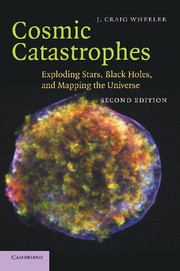Book contents
- Frontmatter
- Contents
- Preface
- 1 Setting the stage: star formation and hydrogen burning in single stars
- 2 Stellar death: the inexorable grip of gravity
- 3 Dancing with stars: binary stellar evolution
- 4 Accretion disks: flat stars
- 5 White dwarfs: quantum dots
- 6 Supernovae: stellar catastrophes
- 7 Supernova 1987A: lessons and enigmas
- 8 Neutron stars: atoms with attitude
- 9 Black holes in theory: into the abyss
- 10 Black holes in fact: exploring the reality
- 11 Gamma-ray bursts, black holes and the Universe: long, long ago and far, far away
- 12 Supernovae and the Universe
- 13 Wormholes and time machines: tunnels in space and time
- 14 Beyond: the frontiers
- Index
13 - Wormholes and time machines: tunnels in space and time
Published online by Cambridge University Press: 14 September 2009
- Frontmatter
- Contents
- Preface
- 1 Setting the stage: star formation and hydrogen burning in single stars
- 2 Stellar death: the inexorable grip of gravity
- 3 Dancing with stars: binary stellar evolution
- 4 Accretion disks: flat stars
- 5 White dwarfs: quantum dots
- 6 Supernovae: stellar catastrophes
- 7 Supernova 1987A: lessons and enigmas
- 8 Neutron stars: atoms with attitude
- 9 Black holes in theory: into the abyss
- 10 Black holes in fact: exploring the reality
- 11 Gamma-ray bursts, black holes and the Universe: long, long ago and far, far away
- 12 Supernovae and the Universe
- 13 Wormholes and time machines: tunnels in space and time
- 14 Beyond: the frontiers
- Index
Summary
THE MYSTERY OF TIME
“Time is the fire in which we all burn,” says a character in a Star Trek movie. This quote captures the hold that time has on our imaginations. Time, especially the fascinating and philosophically thorny issue of time travel, has been a common topic of science fiction since the classic story of H. G. Wells. The ability to manipulate time remains beyond our grasp, but physicists have conducted a remarkable exploration of time in the last decade that once again brings us to the frontiers of physics.
Separation of time from space has been a part of physical thinking since at least the era of Galileo. The equations physicists use to describe Nature are symmetric in time. They do not differentiate time running forward from time running backward. A movie of dust particles floating in a sunbeam would look essentially the same run forward or backward. If the projectionist ran a regular film backward, you would notice immediately. Where does the difference, the “arrow of time,” arise? Why is it that we age from teenage to middle age, but not the other way around? Is that progression immutable?
New approaches to thinking about time came from new thinking about the connectedness of space, and all that came from the desire to make a film that could, among other things, explore issues of science and faith.
WORMHOLES
This particular attack on time travel arose from a work of science fiction.
- Type
- Chapter
- Information
- Cosmic CatastrophesExploding Stars, Black Holes, and Mapping the Universe, pp. 286 - 296Publisher: Cambridge University PressPrint publication year: 2007



